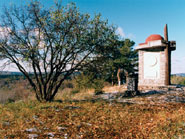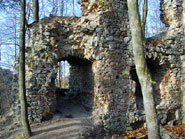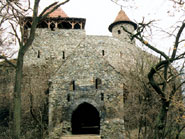CULTURAL AND HISTORICAL MONUMENTS
Welcome to the Blansko region ...
... welcome to an area endowed with a rich history and priceless
architectural monuments, delightful chateaux, romantic castle ruins, stone
windmills, the mysteries of technical monuments, a wide variety of
ecclesiastical buildings, a tradition of arts and crafts...
Castles and Ruins
Blansko
ZThe ruins of a Gothic castle (also known as Blansek - see picture) from
the 13th century, set on a limestone headland above Pustý Žleb (Desert Gully)
five kilometres northeast of Blansko, on a hill opposite the entrance to the
Punkva Caves. It was destroyed during the troubled post-Hussite period at around
the middle of the 15th century.
Nový Hrad (New Castle)
The ruins of a large Gothic castle four kilometres south of Blansko. The
extensive site is formed of the almost indiscernible remains of the original
Starý Hrad (Old Castle). It was burnt out and half demolished during the
Thirty-Year War. It later underwent architectural modifications, during which
its former appearance was restored. It now holds “open days” during the whole
year, with displays of old weapons, historical sword fighting, period music and
craft demonstrations.
Holštejn
The ruins of a castle in Holštejn Valley around 2.5 kilometres from
Sloup. The Hladomorna (Dungeon) Cave, in which many human bones, objects,
clothing and medieval weapons have been found, is not far from the castle.
Čertův Hrádek (Devil’s Castle)
The ruins of a Gothic castle with an unclear history in the Olomučany
area around three kilometres south of the centre of Blansko. This mysterious
little castle is surrounded by a number of legends. Výrova Skála (Owl Rock),
interestingly shaped by frost, can be found not far from the castle.
Chateaux
Blansko
This delightful Renaissance chateau is the dominant feature of the town
of Blansko (see picture). A number of important people have stayed here,
including the doctor and archaeologist Jindřich Wankel and the Austrian writer
Ferdinand von Saar. The most important person with a connection to Blansko
Chateau, however, is Caroline Meineke, wife of future King of England William IV
and heroine of an ancient tale of unrequited love. The chateau park, with its
ancient trees, is also adorned with a number of cast-iron sculptures inspired
principally by Classical times and the Renaissance. The chateau is now home to
the town museum, whose exhibits reflect the tradition of the town’s iron
industry and the production of artistic cast-iron in Blansko. Its historical
interiors and documentation on the history of research into the Moravian Karst
are also of interest.
Rájec nad Svitavou
The most magnificent example of early classicism in Moravia, with unique
elements of French architecture. It also boasts extensive collections of objects
made of crystal glass, Chinese porcelain and copper engravings. Its large Empire
library, with tens of thousands of volumes, and its remarkable picture gallery
are also extremely impressive. In June Rájec Chateau is the venue for the
Concentus Moraviae international music festival of thirteen towns.
Churches
Blansko
The originally Romanesque, now Baroque, Saint Martin’s Church. Its
Station of the Cross from the end of the 19th century and the copy of the Body
of the Crucified by Myslbek are particularly noteworthy. The ancient bell in the
church tower, one of the oldest bells in Moravia, is a valuable monument to the
bellfounder’s art. A commemorative plaque to Caroline Meineke is located on the
site of the original graveyard in the immediate vicinity of the church.
The wooden church from the middle of the 17th century (see picture) is
unique to Blansko. It was built in Nižní Seliště in Sub-Carpathian Ukraine and
consecrated to the Orthodox Saint Paraskiva. An icon of Saint Paraskiva and a
number of other icons from the original décor have been preserved as testimony
to Ukrainian vernacular art. The chapel is an example of the “Lemkov” type of
Ruthenian churches, influenced by the Western European Gothic. It is the oldest
chapel of this type in this country.
Křtiny
The baroque Marian Church of the Name of the Virgin Mary, often called
the “Pearl of South Moravia”, was built according to designs by Jan Blažej
Santini. It is his largest building constructed on the ground plan of the Greek
cross. It has become a famous place of pilgrimage thanks to the statue of the
Madonna, to which a number of miracles have been attributed.
Sloup
The late baroque Church of the Our Lady of Sorrows from the 18th century
by M. A. Caneval has an altar made of black and red marble with a Gothic pieta
statue. Members of the noble Salm family lie beneath cast-iron tombstones in the
local graveyard.
Jedovnice
The originally early baroque Church of Saint Peter and Paul. The modern
main altar, made according to designs by the distinguished artists J. Koblasa
and M. Medek, is the only one of its kind in Europe.
Adamov
The Neo-Gothic Saint Barbara’s Church. The most important feature of the
interior of this brick structure is the “Zwettl Altar”, which comes from the
Cistercian abbey in Zwettl in Austria. The late Gothic carving work is, in a
certain sense, a unique work of art.
Senetářov
The modern Church of Saint Joseph was built in the 20th century from a
design by L. Kolek. Its shape is reminiscent of a ship, as an image of the
church collecting believers on the journey through life and bringing them to the
greatest good - God.
An excursion to windmills and the smelting of iron ore
Rudice - windmill
This windmill of the Dutch type (see picture) now serves as a permanent
exhibition of the history of Rudice, mineralogy, speleology, the iron industry,
smelting and mining. A geological park is open in the grounds of the mill.
Ostrov u Macochy - brick windmill
A windmill of the Dutch type, in a private possession.
Petrovice - - brick windmill
This converted mill of the Dutch type is one of the oldest surviving
mills in the area (open on agreement).
Šošůvka - brick windmill
Only the circular foundations of this windmill of the Dutch type have survived
to this day.
Josefov - The Františka Ironworks
The original blast furnace, built in 1748, was a Belgian-type furnace.
Today it is the oldest surviving furnace in Central Europe. The entire site,
including the surrounding buildings, was the first to be declared a technical
reserve in the Czech Republic. The administration building houses an exhibition
of the iron industry from the Technical Museum in Brno.
Blansko - the ironworks Klamovka, Paulinka and Mariánská
Černá Hora - Panský Brewery
Established in around 1530, the brewery presently produces beer of
excellent quality (tours possible).
Monuments and memorials
Olomučany - Karel Hynek Mácha Memorial
One of the memorials in the area known as the “Forest Pantheon”. It was
built to commemorate the author of the poem Máj “May”. The walls of the monument
are decorated with verses from this work and the legacy of the poet.
Křenek Monument
The monument lies on the Macocha educational trial near the highest point
(Chobot) of the path. It bears the name of the famous traveller and promoter of
the Moravian Karst, who died in Oswieçim (Auschwitz).
The Castle Paths Monument
This interesting monument, with a sundial and quotations from I. S.
Turgenev and A. France, lies on the path from Olomučany to Nový Hrad (New
Castle).








